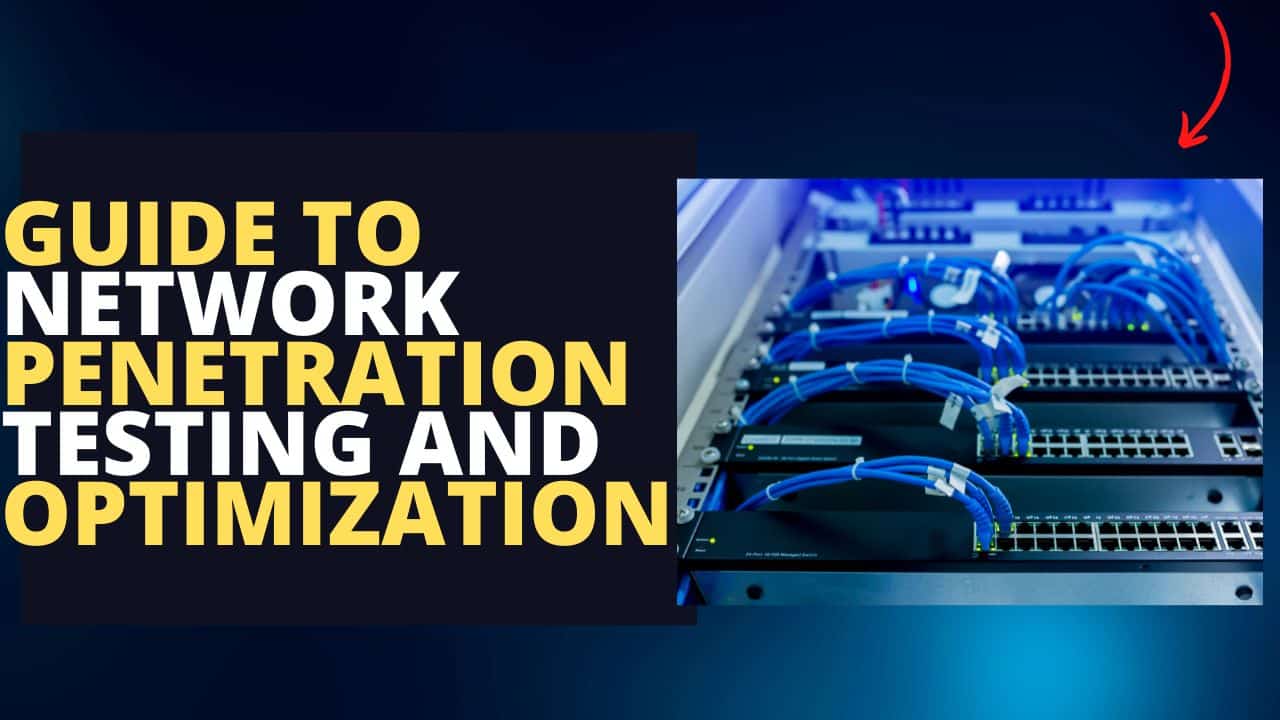In an age where digital progress accelerates relentlessly, cyber-security remains a compelling challenge for companies across all sectors and sizes. The increasing complexity of online threats continues to pose serious risks for businesses making it imperative to take preventative measures in securing one's operations against possible data breaches or hacks by malicious attackers. One solution that effectively addresses many concerns related to system security involves regularly conducting comprehensive network penetration testing techniques, with accurate results on identifying vulnerabilities that could be addressed through more robust safety protocols and security controls.
Understanding Network Security Threats:
Advancements in information technology come with potential risks that could put computer networks' confidentiality, integrity and reliability at stake; these risks are identified as network security threats which are continuously evolving in forms like Malware such as ransomware or malicious email spam phishing manipulations explicitly targeted at unsuspecting users to reveal their confidential information such as login credentials or credit card numbers usually for ulterior motives.
Another common form is the Distributed Denial of Service (DDoS) attack, where servers are inundated with traffic until they crash or become unavailable. As businesses rely heavily on technological infrastructure for day-to-day operations, providing valuable company assets ranging from customer data to company sensitive information protection becomes a priority.
Understanding all network security threats and proactively putting preventive measures in place through system vulnerability assessment and identification testing to ensure optimal secure systems. The dangers posed by cyber-attacks are numerous when it comes to computer networks. Common ones include flooding a plan until it fails through DoS attacks and unauthorized interference in communications through MitM strikes leading to message theft or alteration.

To avoid severe consequences from such impacts in their systems, network supervisors should understand these kinds of menaces thoroughly to choose the best protection solutions, including firewalls, intrusion detection systems (IDS), and encryption protocols capable of defending against them successfully.
For additional improvements to your online security it is highly recommended that you consider reviewing these valuable resources:
- Bitdefender TrafficLight: The Best Way to Browse Securely: Discover how this powerful tool can provide an additional layer of protection and ensure secure browsing.
- Beginner's Guide to Encryption: Gain insights into encryption techniques and understand how encryption can safeguard your data from unauthorized access.
- How to Secure Your Web Browser: Learn effective strategies to fortify your web browser against potential vulnerabilities and mitigate the risk of cyber threats.
Network Security Threats and Attacks:
In recent years there has been a steady increase in sophistication among network security threats and cyber-attacks due partly to technological development allowing these attackers new ways to exploit system vulnerabilities. Malware, phishing scams, DDoS Attacks (Denial-of-service) and ransomware are some of the most commonly faced issues companies pose today. Comprehensively malicious software delivered via email attachments or through downloaded files is termed Malware that brings critical risks to computer systems and servers by stealing sensitive information and extending remote control rights over such systems. Phishing scams are modern techniques hackers employ to gain login credentials from unsuspecting victims through fake emails or websites portraying credible organizations' images. DDoS involves hackers attempting to momentarily overload network traffic so legitimate users cannot gain access to such networks. Locking down particular users' files with them demanding payment before releasing those files falls under ransomware - another significant network threat. To prevent substantial corporate harm, especially in monetary valued information and privacy areas. Network systems must undergo static checks routinely while constantly optimizing security protocols across all levels within the framework.
Advanced Persistent Threats (APTs):
Advanced Persistent Threats (APTs) are advanced cybersecurity threats focused on infiltrating networks discreetly over an extended period undetected while harvesting sensitive data or wreaking havoc within systems gradually. Executed using sophisticated techniques such as malware propagation, social engineering tactics or lateral movement - these targeted attacks bypass traditional security defences easily without raising suspicion on only one stage but over many steps/multiple dimensions of the victims' environments. Furthermore, as APT attacks involve highly customized methods based on deep research into individual target vulnerabilities, detection has become an immense challenge. Therefore, organizations must leverage a multi-layered security approach to continuously monitor and share industry-sector relevant threat intelligence to enhance their overall resilience against such threats.

DDoS Attacks:
One of the most problematic types of cyberattacks nowadays is DDoS attacks, which have considerably increased in prevalence and certainly cause significant disruptions.
These attacks involve overwhelming a website or server with numerous sources until it crashes down completely or becomes unavailable for authentic users to access it. Using botnets networks formed by interconnected compromised computers allows attackers to efficiently disguise malicious requests as genuine traffic, making identification quite challenging for defenders. DDoS carries consequences ranging from lost revenues to significant damage to a business reputation; essential services such as healthcare or emergency response also suffer disruption.

Although such practices are not novel, they have become more widespread due to today's proliferation of "connected devices" that offer effortless opportunities for recruitment into botnets. To minimize the risk posed by" DDoS", companies must adopt a well-thought-out approach: network segmentation, intrusion detection/prevention firewalls, content delivery networks (CDNs), and load balancers alongside traffic scrubbing plans will help achieve overall resilience against these threats. In addition, regular assessments/tests will enable identifying these vulnerabilities, which attackers could efficiently utilize to their advantage.
Also take a look at this IBM Data Breach Report cost that has some informative, interesting slides.
Reconnaissance and Intelligence Gathering:
When conducting a thorough network penetration test before actual hacking attempts: reconnaissance & intelligent data-gathering must take place first. Their goal is to identify the targeted device ecosystem's weak and entry points; this helps you plan where & how you'll execute attack scenarios successfully without being noticed. Therefore, two key processes happen here: Recon and Intelligence Gathering.
Both disciplines serve as critical resources, offering valuable upfront insights before making cyber-war moves on a desired target device. Reconnaissance can either be Active or Passive- ensuring maximum coverage without alerting target devices prematurely, regardless of chosen approach methods during cyber-spying activity timeframes! Activities such as mapping device location within existing networks using public-facing data sources (social media) combined with deep-network high-speed probes are necessary for root-cause activities.

Meanwhile, Intelligence Gathering involves a deeper approach to identify possible system vulnerabilities before attackers do. It includes procedures assessing network protocol communication layers on reachable devices, open ports & associated services to detect potential flaws present. Using standard methods, a general classification of software version vulnerabilities must also be mapped against existing device inventory. Finally, before any actual exploit activity occurs on the target device ecosystem, analyzing log files revealing possible patterns of attack behaviour might help prevent a breach scandal critically impacting both business reputation and system downtime & performance stats.
Types of Penetration Testing:
To assess a network's security systematically, firms use network penetration test performed by testing. This process emulates simple assaults to decrypt vulnerabilities, determine their level of damage and implement necessary security measures. The significant types of penetration testing are:
Network Penetration Testing Process:
The primary purpose of network penetration testing is to discover any security gaps within the existing system. The process utilizes tools and techniques emulating an attacker's strategies to proactively fix flaws. At the start of this process is reconnaissance, where penetration testers collect publicly available information by scanning open source intelligence data, mapping out the network's infrastructure and vulnerability management reporting.
The second step includes enumeration, which identifies user accounts giving intruders access to sensitive data, including passwords that can later be used by attackers against the system. Initial access achieved via opening weak points within the system's defences enables malevolent actors to elevate their privileges within computer systems before moving towards lateral movement, thus moving further into deeper levels while seeking business-critical information.

Given this possibility, social engineering techniques like phishing scams or pretexting attacks are sometimes incorporated for more authentic test cases. The final stage in penetration testing is reporting all findings captured during assessments - followed up with recommendations on mitigating identified risk scenarios wholly. Corporate entities are recommended to undergo regular penetration tests in restive environments as part of their comprehensive cybersecurity strategy to combat rising threats from cyber-criminals attempting malicious activity within company networks.
External Network Penetration Testing:
In today's digital age, external network penetration testing is considered an essential task for every company because it tests and detects vulnerabilities in its digital infrastructure from an outsider's perspective. It helps identify any existing security gaps hackers could leverage to gain unauthorized access or compromise business operations.
Typically external network pen test is involving procedures like surveillance, vulnerability scanning, and targeted attacks on known weak spots; this exercise offers valuable knowledge on securing an organization against cyber threats. The significance of performing this activity regularly cannot be overstated, as cybersecurity threats continue to increase daily. Companies' reliance on digital storage puts sensitive information at risk- making them targets for cyber attacks that may impact financial losses or damage customer relationships. Organizations can adequately remediate detected gaps by conducting regular network penetration tests before hackers take advantage of them and ensure they safeguard corporate assets and end users' privacy rights.
Internal Network Penetration Testing:
Integral to any organization's security protocols, Internal Network Penetration Testing is critical for identifying internal network vulnerabilities. This type of external penetration testing also serves a leading role in underlining that most unauthorized access or data breaches get perpetrated internally within various organizations. Consequently, matching the accuracy level of such identified potential vulnerabilities becomes paramount to enhancing organizational cyber protection. During such assessments, professionals present authentic, authorized or illicit hacking attempts made on sensitive systems or data by exploiting network infrastructure weak points. The goal behind this approach aims at determining weaknesses that rogue hackers frequently use to control victims and recommends remedial steps towards improving cybersecurity risk management strategies across sectors.
Additionally, benefits stemming from conducting these tests are twofold; firstly, they offer resolute defence mechanisms automated tools for companies when defending their operational territories from malicious hacking actors. Secondly- it provides direction in prioritizing actions when patching up detected cybersecurity vulnerabilities while creating advanced workable employee training schedules lessening incident prevention threats exposure risks significantly. Maintaining regular testing schedules enables businesses across boundaries to stay vigilant and well-prepared against internal and external network security attack threats accordingly.
Black Box Testing:
Black box testing has shown effectiveness in identifying issues related to an application's functions and requirements while limiting exposure of its internals from getting into the hands of testers utterly unaware of what they are working on/with. The focus lies in giving users' perspectives while designating test cases through documentation materials like functional specs and typical simulating scenarios one may encounter while utilizing applications/software systems closely mirroring real-world usage patterns. Apart from identifying defects missed during source code reviews, this approach allows highlighting output behaviour rather than delving into how things work behind the scenes, revealing unexpected behaviours one could miss using different methodologies, such as white-box testing. However, some restrictions come with embracing black box testing that limits approaches considering all possible paths of code and figuring out complex interactions between components. Nevertheless, to ensure thorough coverage and quality assurance, many organizations use black-box and white-box testing techniques to identify potential security vulnerabilities even in their network security defences, understanding how the software functions.
Gray Box Testing:
For robust software, amongst other practices, we employ gray-box testing since this involves exposing certain parts of an app while keeping others hidden from testers. Below are ways to approach this advanced test methodology: - Giving parameters like network protocols or API Codes. - Restricted knowledge of internal architecture - Evaluating coding language During these tests, on top of uncovering commonly existing issues, those who use this strategy cautiously tend to identify generally overlooked vulnerabilities, such as privilege escalation, early before they create havoc for end-users or firms operating apps. Gray box tests prove useful when identifying SQL Injecting or cross-site scripting (XSS) attacks, with pen tests making sense only if your team has experts well-versed in programming languages such as Python or Java. These offer a limited view of an app while enabling the team to simulate realistic outcomes, minimizing future attacks. Lastly, it's helpful to note that hiring skilled personnel possessing experience working with complex systems and architectures will enable you to achieve superior results when using this method.
Enhancing Network Security:
This requires an awareness of different types of penetration testing options and common vulnerabilities in networks today. To help bolster your defences. Consider adding these crucial pen testing tactics to your overall security strategy:

Offensive Security:
A proactive approach towards network protection through offensive security techniques means actively attacking a system or network using penetration testing or red teaming.
This is done to pinpoint potential vulnerabilities and weaknesses that might be exploited by malicious actors if not attended to early. Adopting an offensive position helps organizations obtain vital insights into their security readiness levels for taking necessary steps where gaps are identified. While penetration testing mimics attack scenarios on networks and applications, red teaming employs skilled attackers tasked with breaking past defences structures within organizations' architecture.
Despite this aggressive front against potential network and data breaches, other safeguards must still be maintained simultaneously, such as implementing sturdy access controls and frequent updates of both hardware and software, plus training employees for safer computing habits also goes a long way in shielding our valued corporate assets from cyber threats. Offensive approaches should always be complementary to defensive tactics adopted by an organization, thus keeping them equipped to deal with emerging cybersecurity threats as the digital landscape continually grows and evolves.
Active Scanning and Vulnerability Analysis:
Effective network penetration testing relies heavily on two fundamental practices: active scanning and vulnerability analysis. Active scanning involves sending out custom-made packets to targeted systems and analyzing the corresponding responses to detect potential attack points such as open ports, protocols or services.
Vulnerability analysis is equally important as it examines system components notably configuration settings & patch levels- for signs of weakness. Discovering vulnerabilities through this approach allows organizations to take pre-emptive measures before malicious players use them. By scrutinizing networks from these two angles, we gain valuable insights into the actual security posture being presented while identifying opportunities for potential improvements.

In conclusion, by performing network penetration testing, both active scanning & vulnerability analysis -in combination- enables organizations to protect against possible future attacks more robustly and reduce overall risk factors substantially.
Firewall Configuration Review:
To ensure optimal network security, there's an urgent need to review the firewall configuration regularly. A firewall is a vital barrier that protects valuable information against unauthorized access from external sources. During this process, it's paramount to assess the relevant policies and regulations concerning traffic flow for compliance with organizational safety needs. The examination covers appraising all Firewall laws, highlighting redundant or multiplicative ones, and testing their effectiveness while assessing exploitable loopholes by hackers.

Network Infrastructure Testing:
Regularly assessing the performance of all components within a computer network is critical in ensuring its reliability and security. This process essentially involves trustworthy practice referred to as Network Infrastructure Testing. The evaluation covers routers; switches; firewalls; servers applications; interconnected devices etc., appealing built-in security functions that operate efficiently by detecting any deficiencies within the system - before any intrusion from cyber-criminals or ethical hackers seeking an opportunity for nefarious acts.
Wireless Testing:
It's no secret that solid cybersecurity entails having secure wireless networks. Regularly conducting wireless tests is crucial for businesses to identify potential weaknesses vulnerable to exploitation by malicious entities. Wireless tests aim to scrutinize these systems' security posture; therefore, companies implementing multiple protocols must consider this aspect.
Vulnerability Scanning uses automated toolsets explicitly designed for this purpose; it detects usual unintentional configuration missteps such as unencrypted access points, outdated firmware versions or default passwords vulnerable to exploitation by attackers. Penetration Testing focuses on simulating different actual attack vectors against specific threat models, thus providing an ideal mechanism for organizations seeking pen test advanced security measures.

Social Engineering Tests aim to exploit end-users actively through seemingly harmless interactions such as phishing emails – which manipulate users into divulging confidential information/malicious actors gaining access and control over their devices/networks- third parties could be used to identify weaknesses in the network during these tests. Therefore, thorough and holistic wireless testing is paramount for businesses looking to protect themselves from any potential threats and attacks against their systems.
Web Application Security Testing:
Network security must include frequent web application security testing given the increasing complexity in design & development, speeding up deployments and making them vulnerable targets for various types of threats: SQL injection risks, cross-site scripting (XSS) attacks, broken authentication & session management loopholes being most common among all threats.

The best way to plug vulnerabilities is through timely testing using methods like vulnerability scanning or penetration testing, and the results obtained network pen testing are used to prioritize risk remediation strategies. To ensure continued success in the system development life cycle (SDLC). Organizations must develop a comprehensive plan covering all SDLC stages. Such an approach needs integration into every step. From design through deployment monitoring & maintenance on web applications post deployment for a successful defence against attackers.
Mobile Security Testing:
To guarantee the safety and confidentiality of data hosted on mobile devices, mobile security tests significantly matter today. With the growing usage of smartphones and tablets for sensitive-data-accessing purposes, conducting extensive security checks that reveal vulnerabilities in real time becomes mandatory.
The great news is that there are different approaches one can undertake when it comes to this type of evaluation, for instance, manual assessments characterized by human intervention through experimenting with app or system inputs as well as static analyses devoted to scrutinizing source codes without running them Dynamic analyses see apps running within controlled environments monitored behaviour wise.

At the same time, penetration checks simulate actual-world attacks designed to rate system resistance levels. Overall conducting comprehensive mobile security tests remains central in detecting potential risks before hackers exploit these flaws. Consequently, an organization's broad cybersecurity approach must include proactive measures and dynamic application security testing to maintain optimal data protection levels.
Add-on Services:
In the highly competitive business arena of cybersecurity, network protection is becoming an increasingly critical element for business continuity planning. Companies require comprehensive security measures incorporating advanced firewall protection intrusion detection systems (IDS), antivirus software solutions, and an enterprise's capability to safeguard themselves against fraudsters who look for loopholes. These options can come as standalone facilities or be sold together in bundled packages that cater to clients' preferences based on their varying security requirements.
Conclusion
In summary, network security threats and attacks are getting more intricate and sophisticated, requiring robust measures to curb them. Thus, it's critical to utilize comprehensive network penetration testing and optimization processes for enhanced security measures. Organizations should adopt a preventive approach that identifies potential system security weaknesses while implementing corresponding countermeasures to minimize the risks of cybersecurity breaches.
Network policy reviews should also be standard procedure keeping up-to-date with trending cybercrime practices continually. Furthermore, hiring expert employees equipped with skills like ethical hacking or incident response, among others, is paramount for protection against malicious actors online. Therefore, prioritizing network security incorporates regular risk evaluations complemented by efficient mitigation strategies, ultimately shielding sensitive data from unethical malpractices.

